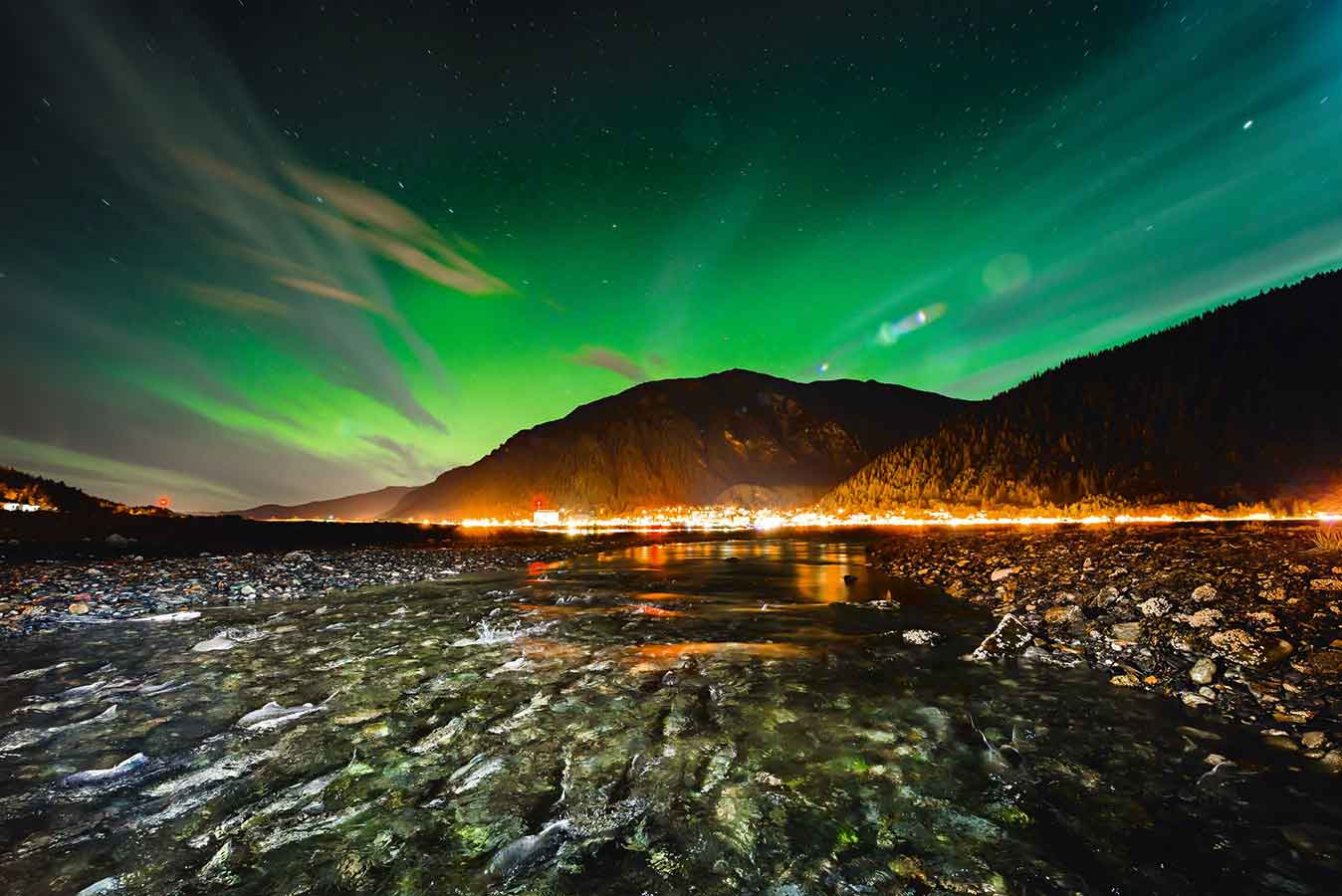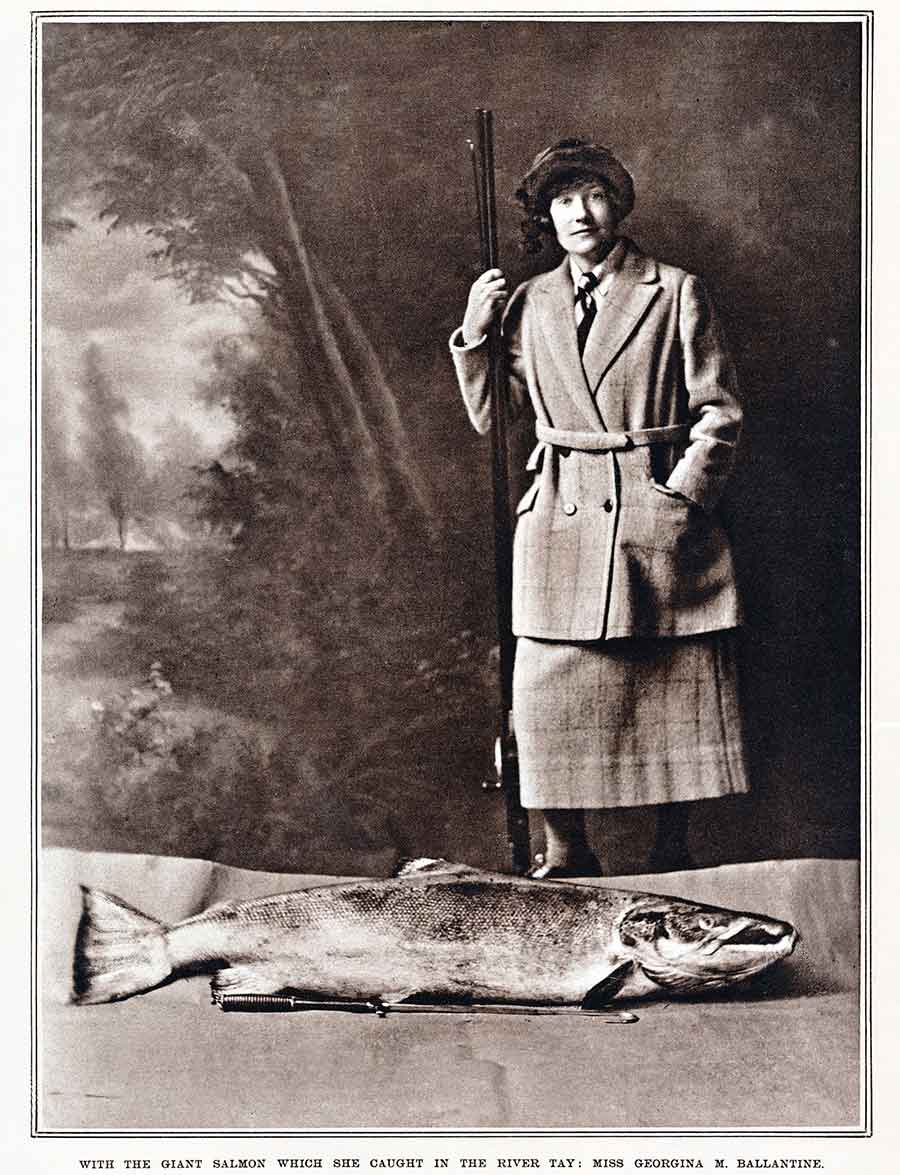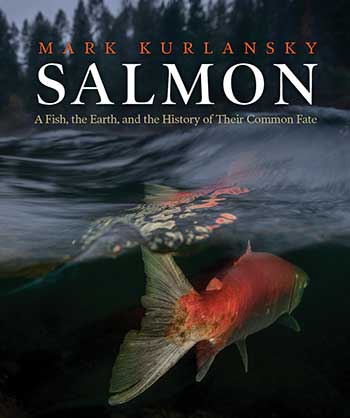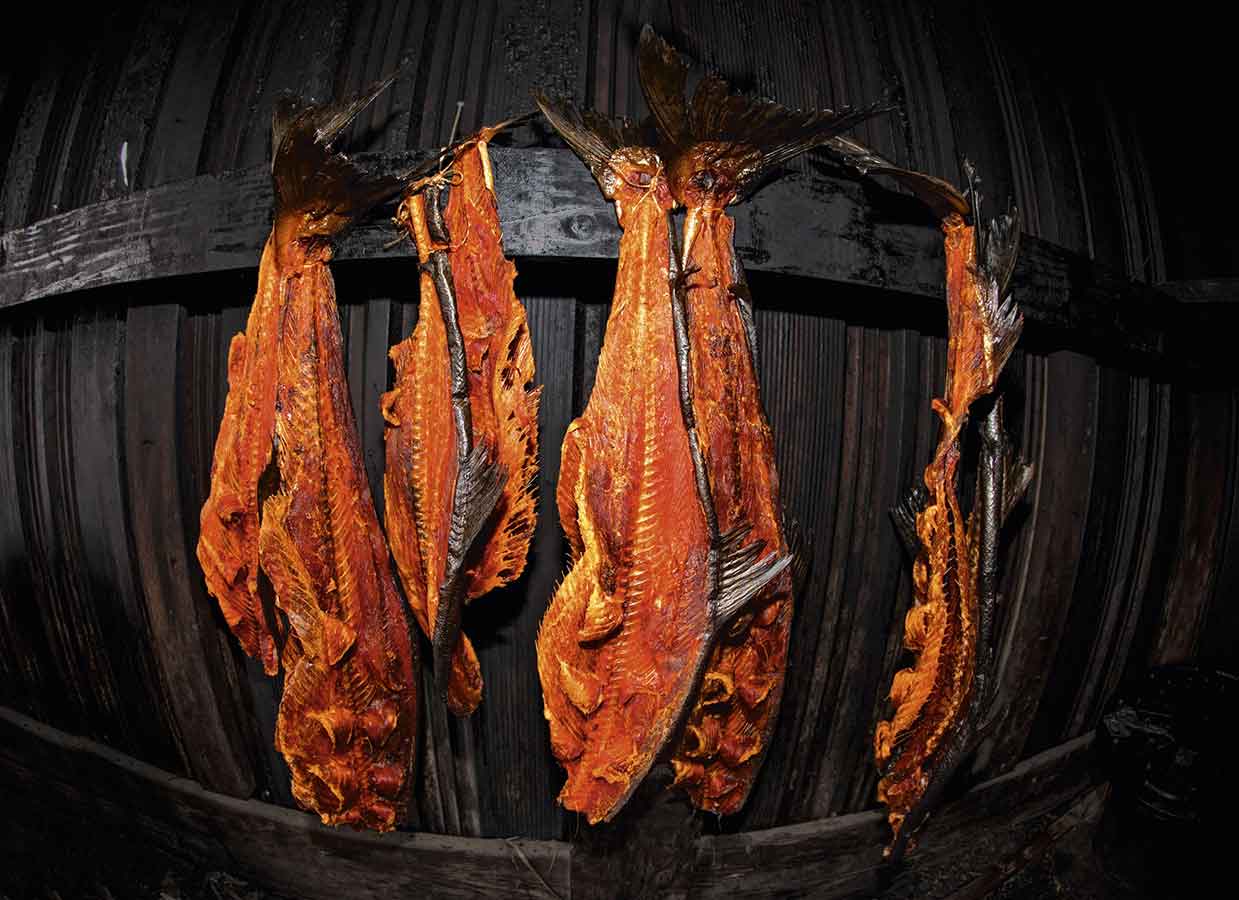Salmon: “When It Was Working”

Pink salmon swimming up Lawson Creek to spawn under the northern lights, while Juneau, Alaska is lit up in the background | photo by Christopher Miller
Rain forests are generally thought of as tropical, but there are also temperate-climate rain forests. The largest temperate rain forest on the planet is on the West Coast of North America. It originally extended from Northern California to Alaska, between the Pacific Ocean and the Pacific Coast Ranges. It is still 1,200 miles long from Oregon to Alaska. The leafy tops of this tall, thick forest hold moisture in, and that moisture drips back into the forest, which is the definition of a rain forest. This rain forest is considered to be richer in species than even the famed Amazonian forest. It was the source of the wealth of Native Americans and, not coincidentally, is the North American range of Pacific salmon.
Moist air from the Pacific blows into the snowcapped mountains, meeting cold air and condensing into rainfall in the forest. An annual rainfall of three meters, or about ten feet, creates a dense, wet, green forest. This forest is home to some of the largest and tallest trees in the world, including coastal redwoods, Sitka spruce, and Douglas firs. Coastal Douglas firs, the dominant tree, are not a true fir and are considerably larger than their cousins that grow in the mountains. They are famously the home of the spotted owl, which became the subject of a fierce standoff between the logging industry and environmentalists in the 1990s. Some Douglas fir that grew thickly shaded under the forest canopy remained very thin and were used for dipnet poles by tribes such as the Karuk in Northern California who fished salmon in the Klamath River. Before all these magnificent trees attracted lumber companies, they attracted salmon, wooded banks making deep swift rivers and huge fallen trees creating pools in those rivers.
The various peoples of North America’s temperate rain forest have never taken for granted this largesse of nature. Most of them have an identity that is tied to the river on which they live and claim a relationship to it that dates back to when the river was formed. The suffix amish means “coming from,” and many tribes have names of rivers—Swinomish, Suquamish, Duwamish.
They considered it a wondrous thing that the salmon returned on the same week every year to feed the people for the whole year. They believed they owed the salmon respect and gratitude, and if they failed in this, the salmon might stop coming back. Later, Europeans came with no respect or gratitude, and in fact the salmon did refuse to come back.

Georgina Ballantine in 1922 with her sixty-four pound Atlantic salmon caught on the river Tay. It is the largest salmon ever caught on a rod in the British Isles. Lordprice Collection/ Alamy Stock photo.
Many of the salmon myths seem to be allegorical warnings about overfishing. There is a myth of a man with a magical basket trap that keeps filling with salmon so rapidly that he has no time to cook the fish. Finally, there are too many salmon and he curses the basket and it stops catching fish. Salmon was often a mythical character portrayed as passing through the river greeting various plants and animals as “brother” or “nephew.” That there are many reincarnation stories is not surprising, given the life cycle of the Pacific salmon. In one story a salmon is murdered but an egg escapes and so she is born again, and salmon are often resurrected from the bones and bodies of the dead in the lore passed down in Native fishing communities. Indigenous people in British Columbia told of a human village far away at sea. The people of this village could turn themselves into salmon and swim into the rivers to feed the river people. The river people were free to eat the salmon but had to be careful to return all of the bones to the river so the salmon people could return to their village and come again to feed the river people the next year. In one Nez Perce story, Salmon, who is human, tells his human wife that if something happens to him, she must return a part of his body to the river so that he will resurrect himself. The five wolves then hire Rattlesnake to bite Salmon while they kidnap his wife. But when Rattlesnake bites him, one drop of blood falls in the water and from that, Salmon regenerates and rescues his wife. Such myths may be about keeping nutrients in the river for the next run of salmon.
There are many stories of people or animals that treated the salmon with disrespect and the salmon refused to return the next year. The Coos people of the southern Oregon coast told a story of a fisherman who casually tossed away a salmon heart: the fish stopped coming and the people starved. The Tillamook believe that the salmon will become offended if you burn one while roasting them.
Mackenzie was astounded by all the rules to not offend the salmon. Native Americans stopped his exploration party from fetching water with their pot because, the indigenous people said, the salmon in the river disliked the taste of iron. Mackenzie found that his hosts would become extremely upset if the salmon scraps were mistreated. Feeding them to a dog was forbidden. Mackenzie wrote of the Nuxalk in the Bella Coola Valley, the first Pacific people he met at the end of this first-known crossing of North America in 1793, “These people indulge in extreme superstition, respecting their fish, as it is apparently their only animal food.” They would not let the strangers touch raw salmon but would give it to them prepared and would deny them access to the fish-preparation area. The European men would probably have been happier hunting and eating deer or elk, but the locals would not allow red meat on canoes because the salmon would dislike the smell and leave the river.
…
In 1864 Alexander Russel, a Scot, wrote, “The salmon is, in a more than ordinary sense, the free gift of nature, that its importance as an article of food, has been undervalued or overlooked.” But Native Americans did not undervalue or overlook it. To them, the salmon gave itself up so that they might eat, and therefore the people must never forget to give thanks. According to many rain forest communities, salmon were magical people who had five tribes, each living in different villages. These were the five species of salmon that they knew.
It was also believed by many that before the salmon journeyed into the rivers, they sent a few scouts that would report on their treatment so the other fish could determine if they would follow. So it was particularly important to treat the first salmon well. The first and most essential ritual was the first-salmon ceremony. (Although an ancient ritual, the ceremony is still practiced today in many tribes.) The first salmon of the season is cooked and everyone in the community has a small taste. Then the bones are taken to the river. This is usually done at night with torchlight. There is chanting and dancing—the traditions differ slightly for different groups—then the bones and head are placed in the river facing upstream: symbolically the bones have been set on course to swim to the spawning grounds and regenerate.
The most common method to cook a salmon was to place it in water in a box with heated stones so the water would boil. But a first salmon had to be barbecued so that its soul would rise with the smoke and it could see the people respecting it. It also had to be cut lengthwise, not crosswise. Crosswise cuts were an insult.
Normally salmon was barbecued by being skewered on a stick and held over a fire. Another method of cooking besides boiling was to smoke it and dry it for storage. Cured salmon was sometimes rubbed between stones producing a powder called pemmican, which was often eaten by European explorers because it traveled extremely well. Probably the explorers and not the natives gave it the name pemmican, which was known to explorers of the plains as a paste made from dried buffalo or moose meat. The word comes from the Cree language, which originated in the northern Midwest. But salmon pemmican was a staple of the Pacific Northwest.
When salmon was roasted, a pot was sometimes put beneath it to collect the oil. Salmon oil was extremely popular for cooking. Salmon oil could also be traded to upland people, often in exchange for red meat such as elk or deer. Pemmican, salmon oil, and berries was a breakfast dish. A paste was made with salmon eggs, which could also be boiled in soup.
Despite their many folkloric beliefs, these Native Americans had far more scientific knowledge about the Pacific salmon than the European Americans did. The explorer David Thompson, the first to travel the full length of the Columbia and chart it, in 1811, learned from the locals that there were five distinct species of salmon and that they all spawned in different places.
The Native Americans who fished the salmon rivers of the western rain forest were among the most skilled fishermen the world had ever seen. They often sought out falls or other natural obstructions where the salmon slowed in a pool before making their leap, or places where their progress was slowed by a narrowing of the river. In this traffic jam, the salmon were easy prey for dipnets or spears. Celilo Falls, on the lower Columbia, was one of the most famous of these spots. Platforms for using dipnets or spearing were privately owned, and a fisherman needed a family’s permission to perch on one.
But there was also community-owned fishing gear that required a well-organized crew. Nets that were 300 feet long and 8 feet deep—the exact dimensions of a modern setnet in Alaska—were anchored to the shore at one end with stakes while the other end was taken out in the river with a canoe. Gillnets were also used, but the fishermen took care never to stretch them across an entire river.
Some fished with a baited hook and line from a canoe. The bait was usually smelt or sprat, preferably extremely fresh. They used leaders, a stretch of invisible string between the hook and the line so that the fish could not see that the hook was attached to a line. The leaders were made of long strands of women’s hair. Several hairs were woven together, but still, the Native Americans must have been remarkably skilled fishermen to land a large sockeye or a king without breaking this thin leader. Early Europeans made leaders from animal gut; today, transparent nylon is used.
Hooks were made of bone or wood curved into shape by steaming, sometimes with a bone barb to hold the fish on. Nets were made of vegetable fiber such as hemp or kelp. Fishing lines were made of those materials as well, though sometimes from the sinew of whales or the inner bark of cedar. The bark would be twisted into strong line. Stinging nettle and willow saplings were also beaten and their long fibers made into twine. Weights for lines or the bottom line of nets were stones tied with cedar. The floats for the top line were wood, often handsomely carved as fish, birds, or marine mammals. A fish net could have the beauty of a work of folk art.
The weirs the indigenous fishermen built were complicated: saplings, bushes, and baskets trapped the fish. The large rocks that were used to pound the stakes in when building a weir were also often ornately carved. The weirs were usually owned by the community and the fishermen were careful to leave a weir in place only long enough to catch the desired number of fish so as not to block the river migration. There were strict laws governing weirs.
Stone traps of the kind Thoreau found in the Merrimack were also used. They were placed in tidal zones so the fish could swim in when the water was high and were trapped when the tide went out.
Salmon run every year through the Strait of Juan de Fuca to the Rosario Strait to Legoe Bay on their way to spawn in the Fraser River. For millennia the nations of the United States and Canada didn’t exist, but the salmon run did—first sockeye, then chum, a few silver, and a big run of pinks in the fall during odd-numbered years. Along this route salmon pass Mount Baker, a huge volcano that rises ghost-like above the fir treetops and blows every 500 years (it is now due to erupt), as well as a wooded island that is home to the Lummi people. The Lummi call Mount Baker, Komo Kulshan, which means “the great white watcher.”
The Lummi used a fishing technique called a reefnet. Two canoes went out in the bay and aligned their canoes with the run of the salmon. A net was anchored between the canoes. Net lines were anchored behind the net with a series of horizontal lines. This seemed to the salmon like a seabed, but it was inclined upward so the fish ended up swimming over the net. A lookout waited until a thick school was directly over the net to give the signal for the net to be hauled up. This may seem like an awkward and arcane technique, but when the salmon are running, it catches a lot of fish.
…
Native Americans managed their rain forest fisheries so well that, even with abundant catches, the resource was never depleted. The fishermen understood the concept of what biologists today call “escapements”: that a certain number must be allowed to escape capture so that they can go on to spawn. The European Americans chose between protecting nature or developing the land. The Native Americans had to make no such choice because the idea of two separate worlds, one natural and one man-made, did not exist for them. Many North American languages do not even have a word for nature. There is no separate thing called nature; there is simply the world.
What was the secret of their successful management? It was not that they did not fish effectively, base their economy on the fish, or trade fish. But they didn’t chop forests down, they didn’t engage in agriculture, they didn’t build dams, they didn’t build cities—in short, they did not damage the habitat.
Excerpted with permission from “Salmon: A Fish, the Earth, and a History of their Common Fate” by Mark Kurlansky (Patagonia Books, March 2020). All rights reserved.













